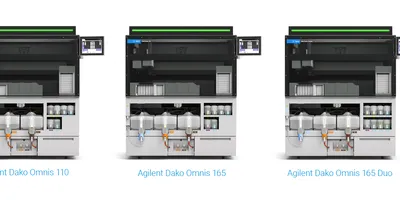In the face of rising test volumes, resource constraints, and increasingly complex diagnostic requirements, modern pathology laboratories require flexible and scalable automation to maintain diagnostic excellence. The Dako Omnis family of instruments, renowned for its continuous, case-based processing, has been expanded with three new models designed to address these very challenges. These systems provide a sophisticated approach to immunohistochemistry (IHC) and in situ hybridization (ISH) staining, offering pathology professionals the ability to tailor their solutions to meet specific throughput, workflow, and diagnostic needs without compromising performance. This expansion moves beyond a one-size-fits-all model, providing a portfolio that empowers labs to optimize their operations and support long-term growth.
How the Dako Omnis Family Addresses Modern Pathology Challenges
Pathology labs are currently navigating a landscape defined by significant operational pressures. The demand for timely, high-quality results continues to grow, while staffing limitations and the rising complexity of diagnostic assays place a strain on existing resources. As stated by Majken Nielsen, associate vice president of marketing and product management in the Clinical Diagnostics Division at Agilent, “We recognize that pathology labs are under increasing pressure from rising test volumes, limited staffing, and growing diagnostic complexity. This solution was developed in direct response to those challenges. Built on customer feedback, these instruments are designed to simplify workflows, enhance diagnostic efficiency, and help labs deliver timely, high-quality results.” The new Dako Omnis instruments represent a strategic response to these industry demands, leveraging automation to streamline processes and maximize efficiency.
The Tailored Dako Omnis Portfolio: Scalable Staining Solutions
The new Dako Omnis family consists of three distinct models, each engineered for a specific lab environment. This tailored portfolio allows laboratory managers and directors to select an instrument that aligns perfectly with their operational scale and diagnostic requirements.
Dako Omnis 110: Precision for Low- to Medium-Volume Labs
Designed for labs with lower to medium daily volumes, the Dako Omnis 110 is built for precision and reliable performance. This model delivers dependable results for up to 110 IHC slides per day, making it an ideal solution for labs seeking to automate their staining processes efficiently without the overhead of a higher-throughput system.
Dako Omnis 165: Efficiency for Medium- to High-Volume Labs
For medium- to high-volume pathology labs, the Dako Omnis 165 is engineered for maximum throughput and seamless consistency. This instrument can process up to 165 IHC slides per day, providing a robust solution for environments where workflow optimization and rapid turnaround times are paramount.
Dako Omnis 165 Duo: Flexibility for IHC and ISH Staining
The Dako Omnis 165 Duo offers the ultimate in flexibility for medium- to high-volume labs. This model is capable of delivering simultaneous IHC and ISH staining on the same platform, which is a critical feature for labs with diverse and complex diagnostic portfolios.
- Immunohistochemistry (IHC): A widely used technique that leverages antibodies to selectively visualize antigens (e.g., proteins) in cells of a tissue section, typically in the context of disease diagnosis.
- In Situ Hybridization (ISH): A precise method for detecting and localizing specific nucleic acid sequences (DNA or RNA) within cells and tissues, providing crucial information on gene expression and chromosomal abnormalities.
By combining these two distinct yet complementary staining methods into a single instrument, the Omnis 165 Duo maximizes throughput and confidence in diagnostic results.
Key Innovations in the Dako Omnis System for Enhanced Lab Efficiency
All new models in the Dako Omnis family build upon the core strengths of the original instrument, incorporating key innovations that further enhance laboratory workflow.
- Continuous, Case-Based Processing: This advanced workflow allows slides from different cases to be loaded and processed simultaneously as they become available, eliminating the need to wait for a full instrument run. This feature significantly reduces turnaround times and provides a more flexible and responsive lab environment.
- Shared Reagents: The use of shared reagents across the entire platform simplifies inventory management and reduces waste. This standardization minimizes the potential for error and ensures consistent results across all assays.
- Integrated Direct Connection: A newly integrated direct connection for de-ionized water and non-hazardous waste dramatically reduces manual handling and technician time. As noted by Jessica Barbour, a senior biomedical scientist who tested the new instruments, “The addition of the direct connection is beneficial, provided there is access to direct deionized water. It is also advantageous to be able to empty the waste while the machine is operational. In the past, there have been instances where non-hazardous waste was not emptied in the morning, which consequently limited the number of slides we could run throughout the day.” This innovation directly addresses a common operational bottleneck, ensuring uninterrupted workflow.
Optimizing Your Pathology Lab's Future with the Dako Omnis Family
The introduction of the new Dako Omnis instrument family marks a significant step forward in providing pathology labs with the tools needed to thrive in a challenging environment. By offering a range of scalable and customizable solutions, these instruments empower professionals to optimize their staining workflows, enhance diagnostic efficiency, and ultimately deliver high-quality, timely results. This launch reinforces a commitment to developing innovative technologies that support diagnostic excellence and provide a foundation for long-term laboratory growth. The tailored Omnis portfolio ensures that labs of all sizes can find a solution that not only meets their current needs but also provides the flexibility to adapt to future demands.












